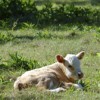 Cull cattle are those that are sold from a herd for lack of performance, lack of resources, or genetic improvement The non-fed beef cattle market (cattle that are not managed through traditional feedlot finishing systems) is comprised primarily of cull cows and bulls. To address liability and food safety concerns, this series of articles discusses some quality defects identified in the non-fed beef market, how to prevent them, and how to address them when they appear in cattle.
Cull cattle are those that are sold from a herd for lack of performance, lack of resources, or genetic improvement The non-fed beef cattle market (cattle that are not managed through traditional feedlot finishing systems) is comprised primarily of cull cows and bulls. To address liability and food safety concerns, this series of articles discusses some quality defects identified in the non-fed beef market, how to prevent them, and how to address them when they appear in cattle.
- Overview of Cull Cow Beef Quality Issues
- Injection Sites and Abscesses
- Horns, Ocular Squamous Cell Carcinoma, and Lumpy Jaw
- Bruising, Condemnation, and Foreign Objects
- Cow Condition and Muscling
- Hide Defects, Contamination, and Non-Ambulatory Cattle
http://edis.ifas.ufl.edu/topic_series_cull_cow_beef_quality_issues
